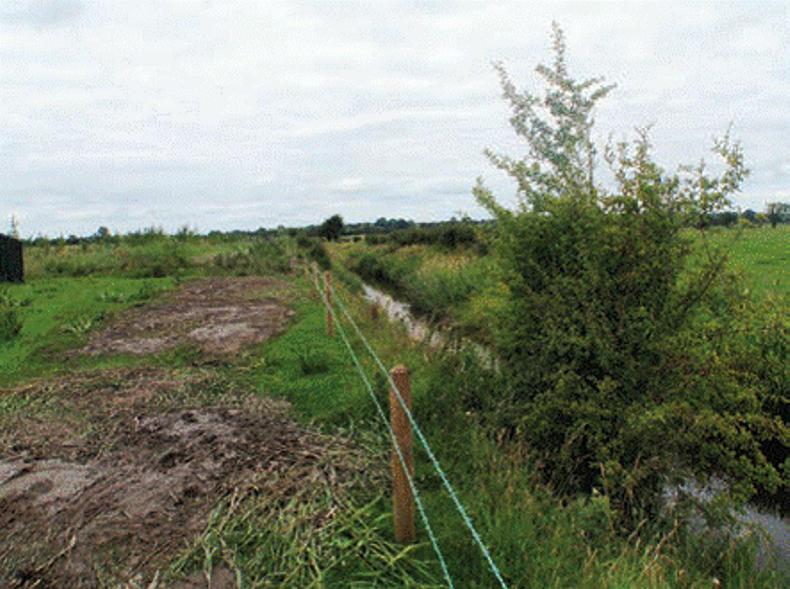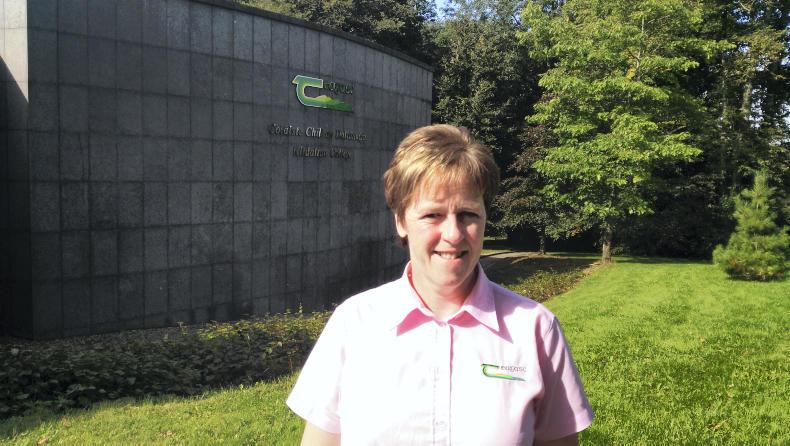Drain and river management can be a contentious issue, especially after the floods last winter. Rivers and drains on many farms have not been maintained for a number of years and as result have become clogged up with silt, overgrown with vegetation or their banks have collapsed and blocked the water flow.
There is a common misconception that you are not allowed to clean rivers and drains any longer and this misinterpretation of the rules has resulted in the neglect of river and drain management.
Teagasc environmental specialist Catherine Keena says farmers are allowed to clean existing drains and rivers once they are not deepening them. She said the best approach to take when planning to carry out work on an existing watercourse is to consult Inland Fisheries Ireland (IFI) first.
Catherine says that it is important to remember that both drains and rivers are considered to be watercourses. Under the Fisheries Acts (1959-2010) fish and their spawning grounds are protected. In-stream works should not be carried out without prior consultation and approval of IFI.
What can be done?
There are a number of measures that can be taken to manage drains and rivers and still be compliant with IFI. Dr James King, IFI fisheries biologist, says the IFI and Teagasc came together to outline the best approach to avoid penalties for maintaining watercourses on farms. The rules are as follows:
Do not disturb the non-working bank slope.Do retain vegetation at water’s edge.Do leave working bank slope intact.Do remove vegetation and silt material from the open channel only.Do not remove stone or gravel.Do place spoil along the bank outside the bank-full line, spreading thinly.Do leave a buffer of 20m at the downstream end of a drain to act as a silt trap.King says the non-working banking (bank opposite where the drainage digger is working) of the slope should be left untouched to ensure its stability. He says vegetation helps to stabilise the banks and is also good for biodiversity.
“Any superficial silt and vegetation can be removed from the open channel,” according to King. He explains the objective should, however, not be to deepen the watercourse lower than its natural level.
“Removing gravel and stones from a river bed can do serious harm to salmon and trout spawning areas, by either uprooting current spawning areas or having a negative effect downstream,” he explained.
Farmers argue for the need to deepen watercourses to improve drain capacity and effectiveness but King says this is not only bad practice but oftentimes has little benefit in terms of draining the field. “A drain is only as good as its outlet. If a drain is lowered below the level of the outlet there will be no drainage benefits,” said King. He also commented that there have been cases where farmers have lowered the level of a watercourse all the way to a public bridge. By lowering the level of the watercourse bed below the box culvert level, erosion can occur under the culvert which in turn can affect the overall stability of the bridge.
Fish habitat
Watercourses provide a habitat for different fish species. It is best to make contact with the IFI before carrying out work to ensure there is no issue with the proposed maintenance. To find one of the regional offices, check the website www.fisheriesireland.ie or call 01-884 2600. July and August are the best months to avoid harming spawning ground or fish habitats. Fish are active at different times of the year depending on the species and their life stage. For example, salmon and trout spawn on gravels in winter and lamprey spawn on gravels in late spring/summer.
Watercourse protection
Catherine Keena says watercourses are valuable habitats for fish but also for plants, invertebrates, otters, frogs, newts, kingfisher and other riparian flora and fauna. She says the value of smaller streams and drains is often underestimated. Fencing off watercourses and providing an alternative source of water is a good way to avoid damage to the river bank and bed. “By fencing off the river you can prevent silt entering and building up in the water,” she explained. In GLAS, many farmers have chosen the protection of watercourses from bovines action. Catherine says this action was included in the GLAS scheme to prevent pollution and prevent the breakdown of vegetation on the banks of rivers.
When cleaning drains be aware of potential damage to fish and their habitats, including downstream.Fish and their spawning grounds are protected under Fisheries Acts.Consult Inland Fisheries Ireland www.fisheriesireland.ie.Allowable drainage works are least disruptive to fish and their habitats when carried out from July to August.Read the Teagasc IFI leaflet Minding our Watercourses for more information.
Drain and river management can be a contentious issue, especially after the floods last winter. Rivers and drains on many farms have not been maintained for a number of years and as result have become clogged up with silt, overgrown with vegetation or their banks have collapsed and blocked the water flow.
There is a common misconception that you are not allowed to clean rivers and drains any longer and this misinterpretation of the rules has resulted in the neglect of river and drain management.
Teagasc environmental specialist Catherine Keena says farmers are allowed to clean existing drains and rivers once they are not deepening them. She said the best approach to take when planning to carry out work on an existing watercourse is to consult Inland Fisheries Ireland (IFI) first.
Catherine says that it is important to remember that both drains and rivers are considered to be watercourses. Under the Fisheries Acts (1959-2010) fish and their spawning grounds are protected. In-stream works should not be carried out without prior consultation and approval of IFI.
What can be done?
There are a number of measures that can be taken to manage drains and rivers and still be compliant with IFI. Dr James King, IFI fisheries biologist, says the IFI and Teagasc came together to outline the best approach to avoid penalties for maintaining watercourses on farms. The rules are as follows:
Do not disturb the non-working bank slope.Do retain vegetation at water’s edge.Do leave working bank slope intact.Do remove vegetation and silt material from the open channel only.Do not remove stone or gravel.Do place spoil along the bank outside the bank-full line, spreading thinly.Do leave a buffer of 20m at the downstream end of a drain to act as a silt trap.King says the non-working banking (bank opposite where the drainage digger is working) of the slope should be left untouched to ensure its stability. He says vegetation helps to stabilise the banks and is also good for biodiversity.
“Any superficial silt and vegetation can be removed from the open channel,” according to King. He explains the objective should, however, not be to deepen the watercourse lower than its natural level.
“Removing gravel and stones from a river bed can do serious harm to salmon and trout spawning areas, by either uprooting current spawning areas or having a negative effect downstream,” he explained.
Farmers argue for the need to deepen watercourses to improve drain capacity and effectiveness but King says this is not only bad practice but oftentimes has little benefit in terms of draining the field. “A drain is only as good as its outlet. If a drain is lowered below the level of the outlet there will be no drainage benefits,” said King. He also commented that there have been cases where farmers have lowered the level of a watercourse all the way to a public bridge. By lowering the level of the watercourse bed below the box culvert level, erosion can occur under the culvert which in turn can affect the overall stability of the bridge.
Fish habitat
Watercourses provide a habitat for different fish species. It is best to make contact with the IFI before carrying out work to ensure there is no issue with the proposed maintenance. To find one of the regional offices, check the website www.fisheriesireland.ie or call 01-884 2600. July and August are the best months to avoid harming spawning ground or fish habitats. Fish are active at different times of the year depending on the species and their life stage. For example, salmon and trout spawn on gravels in winter and lamprey spawn on gravels in late spring/summer.
Watercourse protection
Catherine Keena says watercourses are valuable habitats for fish but also for plants, invertebrates, otters, frogs, newts, kingfisher and other riparian flora and fauna. She says the value of smaller streams and drains is often underestimated. Fencing off watercourses and providing an alternative source of water is a good way to avoid damage to the river bank and bed. “By fencing off the river you can prevent silt entering and building up in the water,” she explained. In GLAS, many farmers have chosen the protection of watercourses from bovines action. Catherine says this action was included in the GLAS scheme to prevent pollution and prevent the breakdown of vegetation on the banks of rivers.
When cleaning drains be aware of potential damage to fish and their habitats, including downstream.Fish and their spawning grounds are protected under Fisheries Acts.Consult Inland Fisheries Ireland www.fisheriesireland.ie.Allowable drainage works are least disruptive to fish and their habitats when carried out from July to August.Read the Teagasc IFI leaflet Minding our Watercourses for more information. 






SHARING OPTIONS